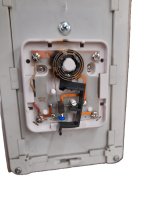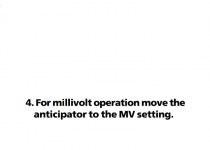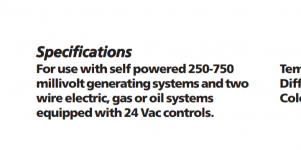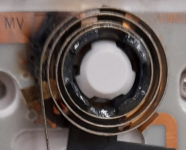I have been assigned to identify and resolve an issue with a thermostat that keeps burning. I would like to request the help of the community.
I am working on a Janitrol 684000 Unit Heater Gas Fired (electrical diagram attached) connected to a thermostat (Dayton 4PU51) that has burn marks (picture attached), which occurred upon installation as I was told by the individual who performed it. I have several questions to tackle the problem.
1) What could cause that issue and how can I resolve it?
2) When I read the Installation and Operating Instructions ( also attached )of the thermostat, it is mentionned in the "Setting the Heat Anticipator"paragraph (page 2 of the manual , second section on the far left) to "Adjust the anticipator to the maximum current draw of the heating system. If this information is not available, check the current draw with an amp meter ". I have never worked on a heater before, and this one is very old. I do not know what is the maximum current it could draw. How practically could I get that information using an amp meter? Where exactly ( around which wire) on the heater on the electrical diagram attached should I put the amp meter?
3) After finding the maximum current the heater could draw, how do I practically adjust the anticipator. When I tried adjusting the metal coil on this burnt thermostat, it started emitting smoke.
4) Fianlly, on the electrical diagram of the heater that I provided, there are six different diagrams. How can I figure out the specific diagram that was used to wire the heater I am working on.
Thank you beforehand

I am working on a Janitrol 684000 Unit Heater Gas Fired (electrical diagram attached) connected to a thermostat (Dayton 4PU51) that has burn marks (picture attached), which occurred upon installation as I was told by the individual who performed it. I have several questions to tackle the problem.
1) What could cause that issue and how can I resolve it?
2) When I read the Installation and Operating Instructions ( also attached )of the thermostat, it is mentionned in the "Setting the Heat Anticipator"paragraph (page 2 of the manual , second section on the far left) to "Adjust the anticipator to the maximum current draw of the heating system. If this information is not available, check the current draw with an amp meter ". I have never worked on a heater before, and this one is very old. I do not know what is the maximum current it could draw. How practically could I get that information using an amp meter? Where exactly ( around which wire) on the heater on the electrical diagram attached should I put the amp meter?
3) After finding the maximum current the heater could draw, how do I practically adjust the anticipator. When I tried adjusting the metal coil on this burnt thermostat, it started emitting smoke.
4) Fianlly, on the electrical diagram of the heater that I provided, there are six different diagrams. How can I figure out the specific diagram that was used to wire the heater I am working on.
Thank you beforehand







